More after the image...
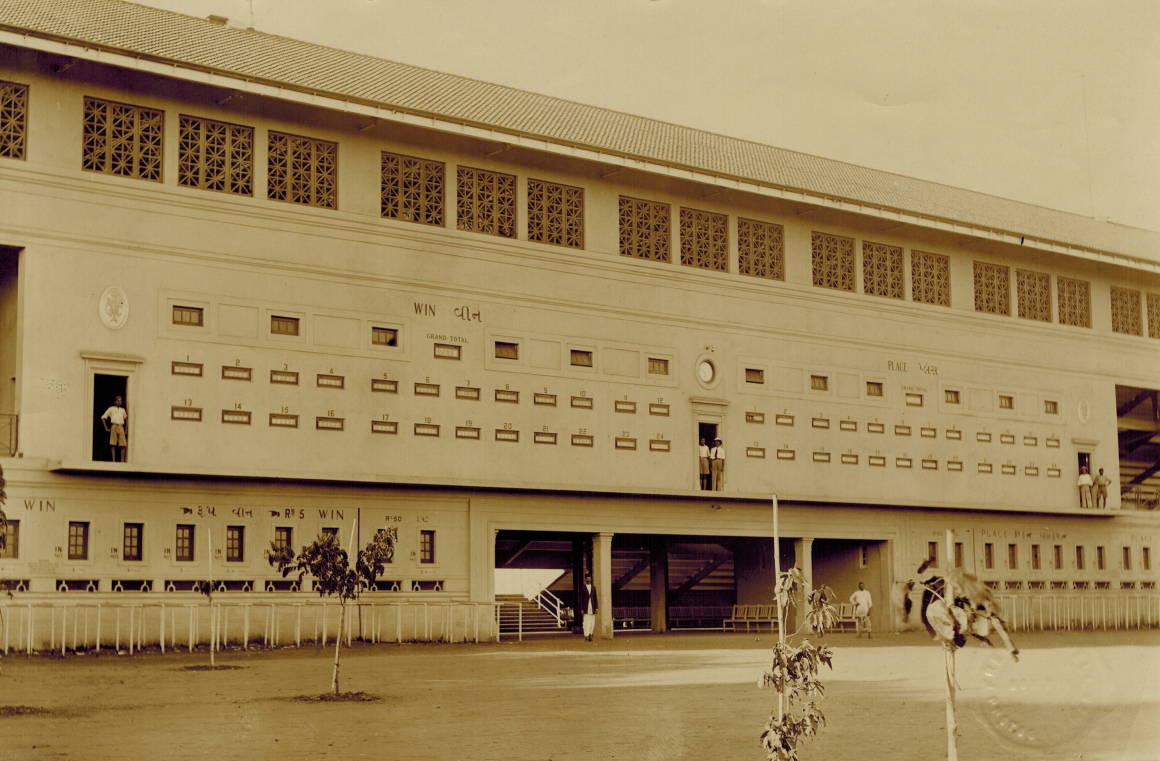
Click on the image to go back to the Photo Gallery
The photographer's stamp on this photo reads FRED MITCHELL PHOTOGRAPHER BOMBAY
Copyright © 2014 Email - totehis@hotmail.com
More after the image...

The writing on the rear of the photograph shown in the image above reads: Back view of Grandstand Showing Machine front. Length of Machine Room about 180 ft (40 Place Issuers 30 Win) Bombay India
The people standing at the first floor level in the image above are at the exits from the Machine Room onto the ledge come walkway, that provides access to the outside of the indicator. This machine room can be seen in the image below. On the ground floor level in the image above, the queueing rails and selling windows are visible that contain the Ticket Issuing Machines (abbreviated TIMs and referred to as Issuers in the previous paragraph), the sales of which the machine room equipment records. This Julius Tote installation was performed in 1925. Prior to George Julius from Automatic Totalisators Ltd inventing the world's first odds calculator in 1927, the runner totals were displayed instead of the odds, as seen on the side of this Grandstand in the image above in the numbered windows. The pool grand totals are also displayed in windows above the Win Pool and Place Pool runner totals. As can be seen in the image above, the Grandstand is divided into two sections left and right. The left hand side relates to the Win Pool. At the first floor level the left hand side has the Win Pool indicator. Above the left hand indicator section is the word WIN with presumably the Hindi or Marathi version of the word to the right. Below that are the words GRAND TOTAL in smaller letters and below them is the Win Pool grand total counter window. Below that again, there are two rows of Runner Total investment counter windows, with the runner numbers 1 to 12 above the first row and 13 to 24 above the second row of windows. At the ground floor level to the left of the centre of the building are the Win Pool windows containing the TIMs for the Win Pool. This is all replicated on the right hand side of the Grandstand in the image above for the Place Pool.
There are 9 Win Pool windows visible on the left side of the Grandstand in the image above, that contain 9 of the 30 Win Issuers/TIMs in this installation, mentioned in the writing on the back of the photograph and is presented in the first paragraph below the image above. There are also 10 Place Pool windows visible on the right side that contain 10 of the 40 Place Pool Issuers/TIMs also mentioned in the first paragraph. It is not possible to determine from the image above how many more windows there are on this side of the building. The remaining 21 Win Pool Issuers/TIMs and 30 Place Pool Issuers/TIMs must be located in selling windows at other locations. Some could be out of sight on the right and left hand sides of the Grandstand image above or on the other side of the building or in another building on the racetrack. It is known that the early larger Julius Tote installations had multiple Enclosures, which I translate into a building that contains a Julius Tote Machine Room, as was the case with the first of the large Julius Totes installed in 1917 at Randwick. As the writing on the back of the original photo shown in the image below reads Machine Room Bombay - 2nd enclosure, I deduce that another photograph of this installation in a company document titled THE PREMIER (JULIUS) AUTOMATIC TOTALISATOR), showing a second Julius Tote machine room at Bombay, must be inside another enclosure at the Western India Turf Club grounds. This second machine room photograph is presented in the image at the bottom of this page.
Machine room view inside Bombay Grandstand above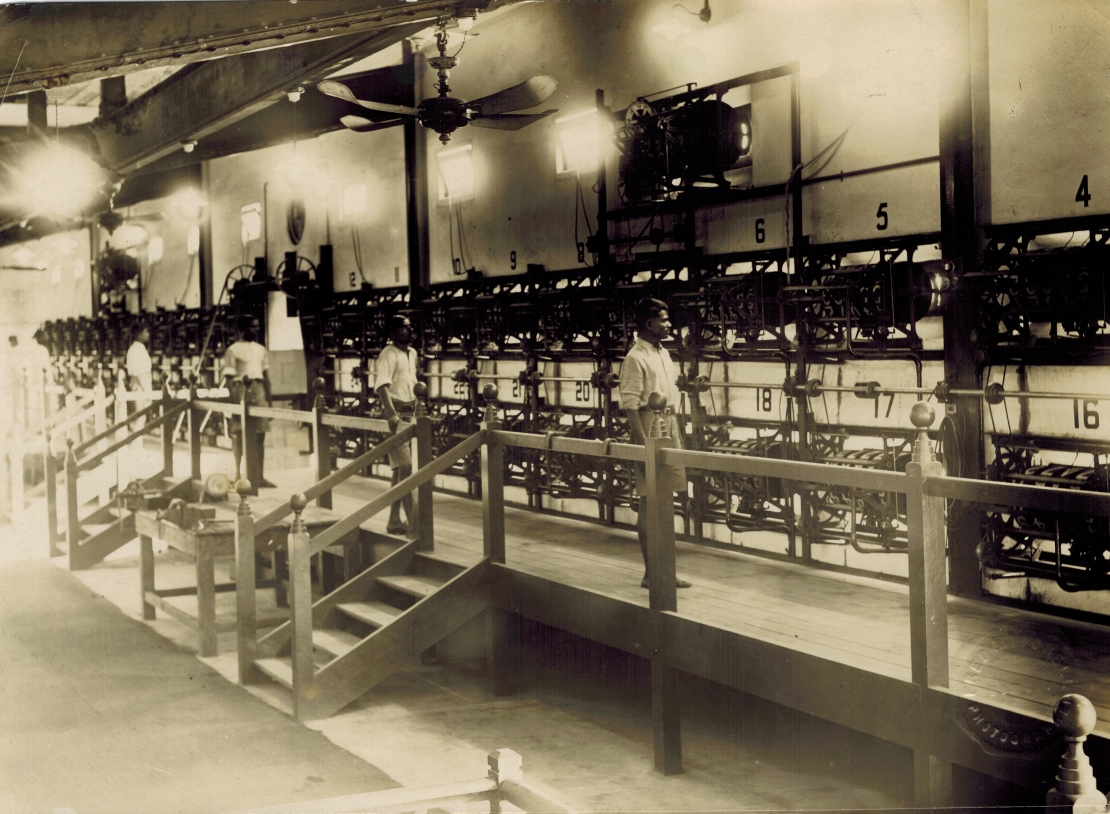
The image above shows the inside of the building at the top of this page. Note the doorway to the outside in the image above to the right and behind the third standing person from the right. Two large drive wheels can be seen top left and top right of the doorway. The outside of this doorway can be seen in the image at the top of this page, in the middle of the first floor walkway with two people standing in it. The clock seen above this doorway in the centre of the Grandstand in the image at the top of this page, can be seen from the back in the machine room image above, in between and above the two drive wheels mentioned. Two long rows of equipment can be seen attached to the wall of the machine room in the image above. These rows consist of adder/indicator units seen from the rear, one of which can be seen in the image below with its large drum counter display. These adder/indicator units were called Combined Adding and Indicating Units, which I will contract to Adder from here on. The numbers above each of the Adders in the image above, correspond to the numbers seen on the outside of the building in the image at the top of this page, above each of the counter windows in two rows numbered 1 to 12 above and 13 to 24 below. Below each of these numbers, inside their respective windows on the outside of the building, the counters of each of the adders in the machine room image above can be seen. The counter side of these adders can be seen in the image below titled A front view of the Bombay Adder in the image above.
Starting at the right hand end of the machine room image above, where adder 4 can be seen above adder 16, a horizontal drive shaft can be seen running horizontally left between the two rows of adders. This drive shaft has pulleys on it which drive pairs of belts, one for the corresponding upper row adder and one for the lower row adder. The drive shaft extends to the doorway previously mentioned, with the two large drive wheels above it. These two drive wheels are mounted on a shaft that joins them together. I think this is the main drive shaft, that in turn drives the extension of the drive shaft just described that drives each of the near side two rows of adders. Similarly another extension at the far end of this main drive shaft, drops down to the level between the two rows of far adders to drive the shaft that can be seen in the distance continuing to run between the distant two rows of adders to the far end of the two rows in the image above. The furthest of the two large drive wheels above the doorway has a drive belt attached to it, seen slanting down and somewhat to the left, extending down towards the wooden elevated walkway. It is not clear where the bottom of the belt meets the drive motor but it could be below the walkway. This belt is interesting from an OH&S (Occupational Health And Safety) perspective as an exposed moving belt would not be allowed nowadays, never mind the slip trip fall hazard it represents obstructing a walkway, even when it is stationary.
At the height of the clock that was mentioned above the doorway in the machine room image above are two more adders. These are the Grand Total Adders previously identified on the outside of the Grandstand building. One is seen above the right hand two rows of adders in the machine room image above, in between the runner numbers 6 and 8 on the wall and is the Win Pool Grand Total Adder. Similarly the other one is at the same height on the opposite side of the clock mentioned, horizontally positioned in the middle of the distant two rows of adders. This is the Place Pool Grand Total Adder. On the Grandstand outside view in the image at the top of this page, the location of this grand total adder can be seen in the right hand half of the indicator. Above and in the middle of this right hand half of the indicator, the word PLACE can be seen. Below and to the right of this word, are the words in much smaller hard to read text GRAND TOTAL, below which the counter of the Place Pool Grand Total Adder is located. The Win Pool Grand Total Adder is easier to see as it is closer in the left hand half of the indicator, below and right of the word WIN, under the smaller text words GRAND TOTAL.
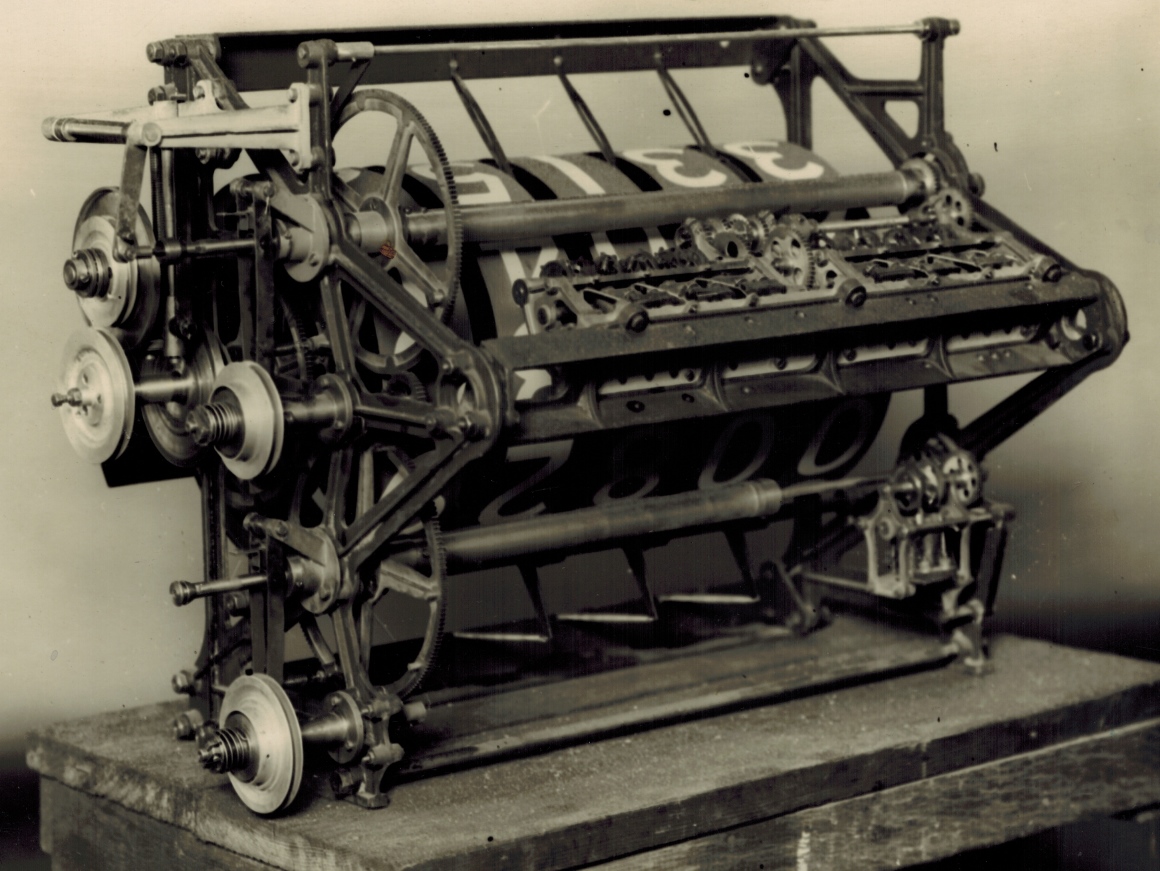 A rear view of one of the Bombay Adders seen in the image above
A rear view of one of the Bombay Adders seen in the image above
The image immediately above shows the rear view of the type of adders that can be seen in the machine room image above, where all the people in that image are looking at this rear view of these adders. The pairs of drive belts on the pulleys mounted on the drive shaft previously described visible in the machine room image above, connect to each adder via a pulley seen in the image immediately above. This main input drive pulley seen on the rear view adder image above, that these belts connect to on their respective adders, is the leftmost pulley on the adder at mid height level.
The adding function performed by these adders is implemented as three electromechanical shaft adder assemblies. Two of these assemblies are located side by side and can be seen slanting away from the viewer in the image above. They are attached to the two parallel mounting bars running the width of the adder at the most rearward protrusion of the adder, which is on the near side, about half way up.
A front view of the Bombay Adder in the image above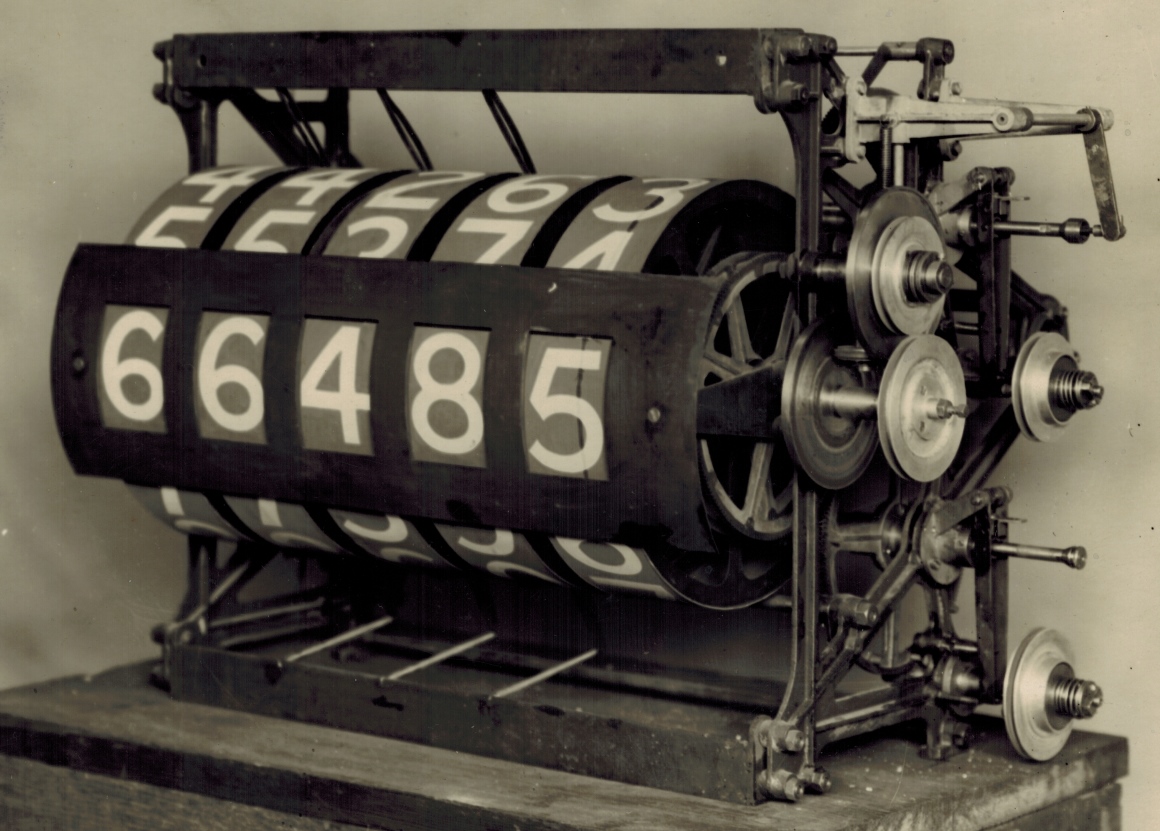
The drum counter seen in the front of the view of a Bombay Adder above, can be seen for each of the adders in the image at the top of this page, below each of the runner numbers. As can be seen in this indicator in the Grandstand image at the top of this page, there are 24 runners for the win pool and another 24 runners for the place pool meaning there are 48 of the adders in the image above one for each of the adder drum counter windows. That takes care of every possible runner in a race. There are however another two adders required for the Win and Place Pool Grand Totals, making a total of 50 adders installed in the Julius Tote installation in this Grandstand building alone.
The main drive pulley for these adders previously identified in the rear view image above, is more easily identified in the front view image immediately above, as it is the closest pulley seen in this adder image.
The image below proves that there was more than one enclosure in this Bombay Julius Tote installation. As the image above titled Machine room view inside Bombay Grandstand above is described as the second enclosure, which is the same building as the one at the top of this page, it is probable that the image below shows the first enclosure Julius Tote Machine Room at the Western India Turf Club in Bombay.
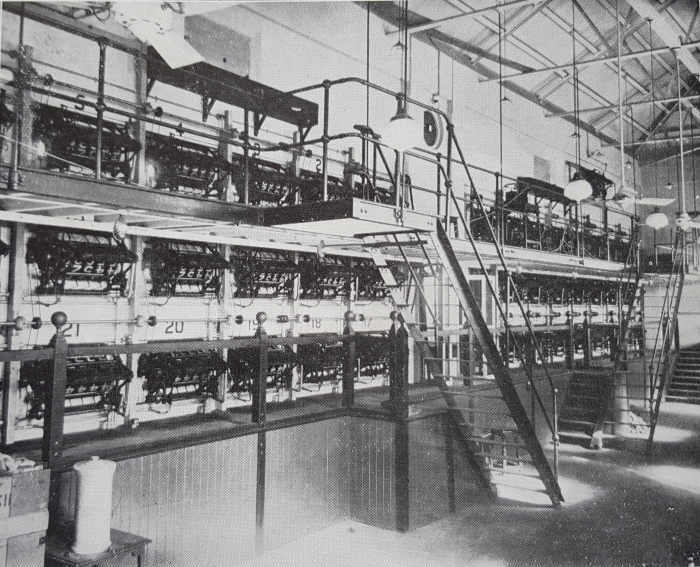 Another Enclosure Machine Room of this Bombay Julius Tote
Another Enclosure Machine Room of this Bombay Julius Tote
The image above titled A rear view of one of the Bombay Adders seen in the image above shows the detail of the Combined Adding and Indicating Units clearly visible in the Machine Room image immediately above titled Another Enclosure Machine Room of this Bombay Julius Tote.
Full sized versions of the three images above the last image can be seen in the Photo Gallery accessible by clicking on the image at the top of this page and selecting their associated thumbnails above and below that for the image at the top of this page.